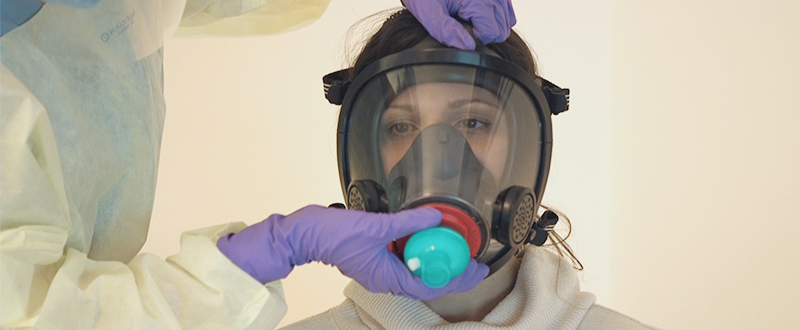Feature: Prototype uses firefighter’s mask to increase capacity of ventilators in hospitals

By Crystal Mackay, MA'05
A team of researchers and engineers has developed a way to modify a firefighter’s facemask in order to help treat patients with COVID-19.
In light of a continuing global concern about the shortage of ventilators, the research team came up with a prototype that uses this protective gear meant for firefighters in order to modify existing non-invasive ventilators to make them safe to use for COVID-19 patients.
Dr. Tarek Loubani, Associate Professor at Western University’s Schulich School of Medicine & Dentistry and scientist at Lawson Health Research Institute has been working with researchers at University Health Network (UHN) and industrial design engineers at General Dynamics Land Systems-Canada to develop the prototype.
COVID-19 is primarily spread through inhalation of respiratory droplets and the most severely ill patients require a ventilator to help them breathe. Non-invasive ventilators don’t require intubation; instead they provide pressurized oxygen to the patient through continuous positive airway pressure (CPAP) or bi-level positive airway pressure (BiPAP) machines. Dr. Loubani says these ventilators aren’t currently being used because they pose a risk of spreading the virus to others in near proximity.
“We have lots of non-invasive ventilators in hospitals, but we aren’t using them right now because they don’t have a tight seal, so they have the potential to spew the virus,” said Dr. Loubani who is also an Emergency Room physician at London Health Sciences Centre. “COVID-19 is unique because it attacks both the upper and lower parts of the respiratory tract, so it’s contagious like a cold and deadly like pneumonia. And that combination is what is causing so many problems.”
The prototype uses a modified firefighter’s mask with a gasket and 3D printed parts to create two tight seals – one around the patient’s nose and mouth and another around the face. Patients breathe in and out of a filter that captures any viral particles before they are released to the air. It can be used with any non-invasive ventilators in order to keep the virus contained. All the parts are designed to be taken apart, sanitized and reused.
The plan is to test the prototype on patients at LHSC’s Victoria Hospital and University Hospital, with plans to expand to the University Health Network (UHN) in Toronto.
If it proves to be effective, the hope is to make the design open-source so that any hospital around the globe with access to a 3D printer and who could source the firefighter’s masks, could create them. With help from General Dynamics, the team also plans to create a kit that would include all of the parts to modify the ventilators.
Dr. Loubani says he is grateful to LHSC and General Dynamics for collaborating so swiftly to make this idea a reality.
“Just over a month ago this was only an idea; and now we have a working prototype,” he said. “COVID-19 came like a tsunami. And this project was like building a speed boat while we were watching that tsunami bear down on us.”
The trial is being supported with funding from Glia, an organization internationally recognized for producing medical supplies that are easily accessible can be manufactured in low-resource settings.








